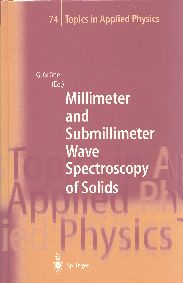Book Review

Millimeter and Submillimeter Wave Spectroscopy of Solids
(Topics in Applied Physics, Vol. 74)
G. Gruner, ed.
Springer, 1998, 286 pages

|
 illimeter wavelength electromagnetic
radiation occupies
the last frontier between microwaves and long infrared radiation. In this
part of the spectrum, roughly 10 to 1000 GHz (0.33 to 33 cm-1,
or 30 to 0.3 mm), it is still very difficult to generate coherent
radiation sources. For example, one source uses a beam created by
focusing a pulsed laser onto a semiconductor. This beam has an
average power of only 10 nanowatts, or about 1/10 the power of
the thermal background noise. Each pulse only contains about
50,000 photons. Yet even this tiny signal is enough to demonstrate
the tremendous potential of terahertz radiation.
illimeter wavelength electromagnetic
radiation occupies
the last frontier between microwaves and long infrared radiation. In this
part of the spectrum, roughly 10 to 1000 GHz (0.33 to 33 cm-1,
or 30 to 0.3 mm), it is still very difficult to generate coherent
radiation sources. For example, one source uses a beam created by
focusing a pulsed laser onto a semiconductor. This beam has an
average power of only 10 nanowatts, or about 1/10 the power of
the thermal background noise. Each pulse only contains about
50,000 photons. Yet even this tiny signal is enough to demonstrate
the tremendous potential of terahertz radiation.
Unlike ordinary radio waves, terahertz radiation is strongly
absorbed by common materials. Even air efficiently absorbs most
wavelengths (except for a narrow window around 96 GHz). Thus,
these ultra-short radio waves are not useful for communication;
but they can provide much information about the physical properties
of matter. Millimeter wave measurements of solids can be used to
study vibrational resonances (phonons), ferroelectric phase transitions,
and photoinduced dissociation of Cooper pairs (which carry charge
in superconductors). In this region, resonance spectra are
usually fairly broad and nondescript. However, the absorbance
spectra of some inorganic materials at these wavelengths contain a
wealth of unexpected detail. The fine structure absorbance spectrum
of rubidium silver iodide crystals, for example, when cooled to 5K,
exhibits thirty extremely narrow peaks between 10 and 30 cm-1
representing a complicated sequence of phase transitions, as
described in the chapter by Kozlov and Volkov.
Moreover, terahertz waves are very useful for subsurface
imaging of small objects, ranging from computer chips to metals
and ceramics. Millimeter waves are particularly efficient at
detecting the presence of water. With longer wavelength millimeter
radar, proportionately larger objects, or even persons hiding
behind a wall, can be visualized.
Other millimeter wave radio sources, such as avalanche (IMPATT)
diodes and Gunn diodes, and the older, but still sophisticated
Russian technology of backward wave oscillators (BWOs), can emit
up to 200 mW of power. BWOs are particularly useful for
spectroscopic studies.
Each chapter in this book is written by a different researcher.
Topics include terahertz time-domain spectroscopy, coherent
source submillimeter wave spectroscopy, waveguide configuration
optical spectroscopy, far-infrared Fourier transform spectroscopy,
and magneto-optical millimeter wave spectroscopy. All the chapters
are well-written, albeit sometimes with a heavy foreign accent.
The chapter on FTIR by Genzel contains a detailed explanation of the
principles of this important technique. The enthusiasm expressed
by these physicists about their cool new toys is highly infectious.

November 24, 2005
Back


 illimeter wavelength electromagnetic
radiation occupies
the last frontier between microwaves and long infrared radiation. In this
part of the spectrum, roughly 10 to 1000 GHz (0.33 to 33 cm-1,
or 30 to 0.3 mm), it is still very difficult to generate coherent
radiation sources. For example, one source uses a beam created by
focusing a pulsed laser onto a semiconductor. This beam has an
average power of only 10 nanowatts, or about 1/10 the power of
the thermal background noise. Each pulse only contains about
50,000 photons. Yet even this tiny signal is enough to demonstrate
the tremendous potential of terahertz radiation.
illimeter wavelength electromagnetic
radiation occupies
the last frontier between microwaves and long infrared radiation. In this
part of the spectrum, roughly 10 to 1000 GHz (0.33 to 33 cm-1,
or 30 to 0.3 mm), it is still very difficult to generate coherent
radiation sources. For example, one source uses a beam created by
focusing a pulsed laser onto a semiconductor. This beam has an
average power of only 10 nanowatts, or about 1/10 the power of
the thermal background noise. Each pulse only contains about
50,000 photons. Yet even this tiny signal is enough to demonstrate
the tremendous potential of terahertz radiation.
